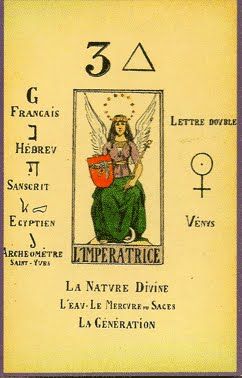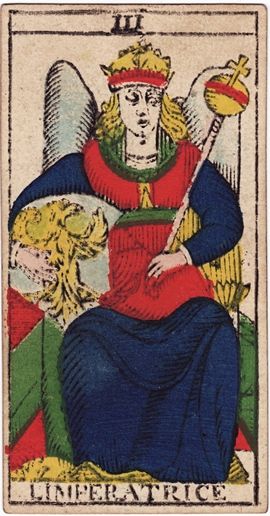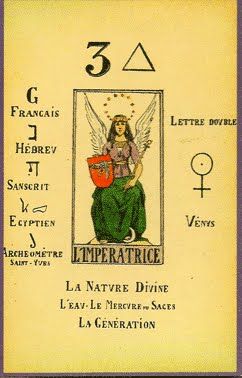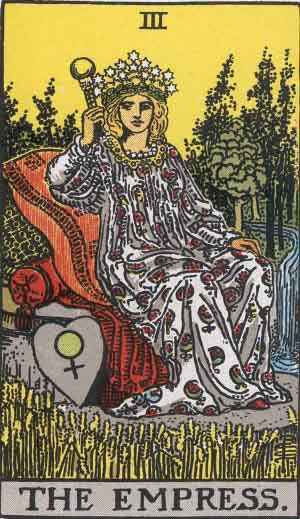Tarot Deep Dive - The Empress
- Dustin

- Aug 8, 2020
- 6 min read
In this series we are going to dive into the history of the imagery found in the tarot, the meaning of the card and how it changed over time, and the symbols present within what is arguably the most well known tarot deck of today - the Rider-Waite (Smith) Tarot Deck. So grab your favorite RWS deck, a cup of tea or coffee, and join me live on Sunday mornings over on YouTube as we Deep Dive into each one of the 21 Major Arcana cards continuing with the motherly Empress. The Queen, The Empress, The Daughter of the Mighty Ones

The great matriarchal archetype of the the Queen is a figure we have known for time in memoriam. From Cleopatra to Elizabeth, strong powerful matriarchs have had a long history within western culture from myths and legends, to religious and historical texts, the Queen and Empress figure is embedded in our culture. The earliest depictions of this card present us very literally with an Empress figure in line with whomever the current queen was. Many decks commissioned by courtiers would have the currently enthroned Queen and King of their respective court memorialized in the Empress and Emperor cards respectively. In our earliest example in this series, the Visconti Sforza deck, it is believed to depict Bianca Maria Sforza who was the Queen of the Romans and Holy Roman Empress when she became the third wife of Maximilian the First. In this card we see her enthroned, in a golden robe, holding the scepter of power, and holding a shield with a heraldic imperial eagle.
When we look at the card in this historical context, we see the Empress in the light that the society of the time saw them as, consort to the Emperor with the task of mothering heirs to preserve the empire and build a lasting dynasty. This notion of being the incarnate of motherhood is a theme we see carried forward through time to modern depictions and interpretations of the card. Often we see this combined with the Papus depiction of the Empress.
As Tarot evolved and took on more and more esoteric and religious associations we see many associations come into being with The Empress, such as her association with Venus, Aphrodite, Mary, and even the Woman of the Apocalypse. Now this is why I harp on the significance and importance of art history in the study of the tarot. When I first laid eyes upon Papus' depiction of The Empress card I instantly recognized it as a depiction of the Woman of the Apocalypse. This classical icon is a depiction of Chapter 12 of the Book of Revelation. This icon is often associated with the Virgin Mary. Here is my terrible summary of this story: A woman gives birth to a male child which a dragon (the Devil) wants to eat. (Baby eating dragon, a classic.) The baby is whisked away to heaven (beam me up Scotty!) and the woman escapes into the wilderness. The angry dragon peruses her, and so the woman is gifted wings to escape. When she flies away the dragon attempts to fell her by unleashing a torrent of water that instead floods the world. Angry about his defeat the dragon decides to take his revenge on any of the "remnant of her see" (the followers of Christ.) One significant symbol from this icon is actually used in the RWS depiction of the Empress, the crown of 12 stars, sometimes associated with the 12 Tribes, or the 12 signs of the zodiac, but also associated with the Woman of the Apocalypse which ties directly into the motherly association we see from the past in the context of mothering a royal, or in this case sacred, lineage.
If we look at these two major archetypal depictions of the card we can begin to see how Arthur Edward Waite and Pamela Coleman Smith synthesized their rendition of The Empress. We can see the evolution of this not only visually but in the interpretation of the card as well:
De Mellet (1781): The Queen.
Levi (1855): The Hebrew letter Gimel, the Empress. The word, the triad, plenitude, fecundity, nature, generation in the three worlds.
Mathers (1888): The Empress. Action, plan, movement in a matter, initiative.
Golden Dawn (1896): The Daughter of the Mighty Ones. Empress. Beauty, pleasure, success, luxury; sometimes dissipation, but only with very evil cards.
Waite (1910): The Empress. Fruitfulness, action, initiative.
Crowley (1944): It is impossible to summarize the meanings of the symbol of the Woman, for this very reason, that she continually recurs in infinitely varied form. "Many-throned, many-minded, many-wiled, daughter of Zeus. "In this card, she is shown in her most general manifestation. She combines the highest spiritual with the lowest material qualities. For this reason, she is fitted to represent one of the three alchemical forms of energy, Salt. Salt is the inactive principle of Nature; Salt is matter which must be energized by Sulphur to maintain the whirling equilibrium of the Universe. (Which on a side note is interesting considering I would personally associate The Empress with the White Queen: Because Mercury, or the White Queen, is fluid and needs an active force to define and shapes her - this, in alchemy, is The Red King, or Sulphur. The union of Red King and White Queen is known as the alchemical marriage in illustrations found in manuscripts. This union will eventually lead to the allegorical offspring: the Philosopher’s Stone.)
The Symbols
The Crown of Stars

Twelve stars adorn the diadem of The Empress signifying her royal position. Often thought to represent the twelve tribes of Israel or the twelve signs of the Zodiac. Also closely associated with the twelve star crown found on the Woman of the Apocalypse.
The Scepter

The Scepter has long been a phallic symbol of power. Per A.E. Waite it is "surmounted by the globe of this world" indicating her rulership over this world of existence. The scepter represents the sovereign's temporal power and is associated with good governance. A traditionally symbol that has its roots in the most ancient civilization of Mesopotamia.
Gown of Pomegranates

Her regal gown of white fabric, white being a symbol of purity, lends to this cards association with Mary. On the cloth we what some have considered flowers, but many identify as pomegranates which would connect to Waite’s remark “the fruitful mother of thousands”. Pomegranates also have a distinct association with the goddess Persephone, Empress of The Underworld. These also undoubtedly echo the symbol of Venus found on the shield to the left.
The Shield

The Shield is a symbol we see carried through the entire visual story of the Empress card. This heart shape shield is emblazoned with the symbol of Venus, which in Golden Dawn is a symbol representing the unity as it represents the tree of life. Hearts naturally are associated with love and caring, while shields are symbol of protection and defense.
Trees & Stream

Trees represent stability and growth, and water represents not only emotion and intuition but nourishment in the case of this card. It is thought that Cypress Trees are depicted specifically because the cypress was associated with death and the underworld because it failed to regenerate when cut back too severely.
Fields of Wheat

The wheat is a symbol of fertility and growth, with an association and dependence on the sun (the sacred masculine). A representation of nourishment, like the water, reinforces the maternal and matriarchal nature of The Empress.
As always be sure to check out our live discussion on this very topic over on YouTube:
References:
Butler, B. Dictionary of the Tarot. New York: Schocken Books, 1986.
Chang, T. Susan. Tarot Correspondences: Ancient Secrets for Everyday Readers. Llewellyn Pulbications, 2018.
Crowley, Aleister (aleister Crowley). Book of Thoth - (Egyptian Tarot). Red Wheel/Weiser, 2017.
Dean, Liz. The Ultimate Guide to Tarot: a Beginners Guide to the Cards, Spreads, and Revealing the Mystery of the Tarot. Fair Winds Press, 2015.
Fiebig, Johannes, and Evelin Burger. The Ultimate Guide to the Rider Waite Tarot. Llewellyn, 2013.
Katz, Marcus. Secrets of the Waite-Smith Tarot: the True Story of the Worlds Most Popular Tarot: with Previously Unseen Photography & Text from Waite & Smith. Llewellyn Publications, 2015.
Waite, A. E. Pictorial Key to the Tarot. Dover Publications Inc, 2005.
Wen, Benebell. Holistic Tarot. North Atlantic Books, 2015.
Images Sourced From: https://en.wikipedia.org/wiki/Wikipedia:Public_domain_image_resources

















Когда в отношениях начинают накапливаться проблемы, бывает сложно понять, с чего начать их решение. Иногда привычные разговоры или попытки "договориться" не дают нужного результата, особенно если за конфликтами стоят глубинные страхи, обиды или негативные сценарии. В таких ситуациях полезно обратиться к практикам, которые помогают осознать свои внутренние барьеры и найти путь к гармонии. Я узнала о методе НейроМоделинг, который сочетает арт-терапию, нейрокоучинг и квантовую психологию. Этот подход помогает работать с подсознанием, что особенно полезно в сложных эмоциональных ситуациях. Кстати, присоединяйтесь 21 марта 2025 года к мастер-классу «Звезда успеха» с Алия Шакти!, где можно узнать больше о применении этих техник на практике. Подробнее можно прочитать на сайте https://www.neuromodeling.space/index-ru.html. Думаю, это может быть хорошей возможностью найти новые решения для улучшения отношений.